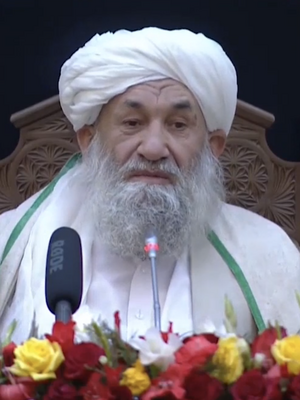Prime Minister of Afghanistan facts for kids
Quick facts for kids Prime Minister of the Islamic Emirate of Afghanistan |
|
|---|---|

|
|
| Government of Afghanistan | |
| Member of | Cabinet |
| Reports to | Leadership |
| Seat | Kabul |
| Appointer | Supreme Leader |
| Term length | At the pleasure of the supreme leader |
| Constituting instrument | 1998 dastur |
| Formation |
|
| First holder | Shir Ahmad |
| Succession | No (Deputy Leader succeeds Supreme Leader) |
| Deputy | Deputy Prime Minister |
| Salary | ؋198,250 monthly |
The prime minister of Afghanistan, officially the prime minister of the Islamic Emirate of Afghanistan, is the head of government of Afghanistan.
The position was created in 1927 as an official appointed by the king of Afghanistan. The holder served mostly as an advisor, until the end of the Kingdom of Afghanistan in 1973. During the 1980s, the position was the head of government. The post was abolished after the US invasion that ousted the Taliban regime, after which a presidential form of government was established which lasted from 2004 to 2021. After the US withdrawal and the re-establishment of the Taliban rule, the post was revived.
The prime minister and government are subject to the instruction of the supreme leader. On September 7, 2021 the Taliban officials who exercised de facto control of Afghanistan announced Islamic scholar Hasan Akhund as acting prime minister in a new interim government of the recently re-established Islamic Emirate of Afghanistan.
Contents
History
Kingdom
The chairman of the Council of Ministers was not the prime minister, but the king. Only during his absence was the prime minister the acting chairman of the Council.
Until 1963, King Mohammad Zahir Shah appointed his relatives as prime ministers. The king also had the power to dismiss or transfer the prime minister. From 1963 onwards, this was changed, stating that the head of the Afghan government was the prime minister, and that the government consisted of its ministers. It was the first time that the king did not play an important role in the government, leaving it to an elected authority. However, it also stated that they cannot engage in any other profession during their tenure of office.
The 1964 Constitution also granted the prime minister the power to summon the Electoral College in case of the death of the king. The prime minister only answered to the Wolesi Jirga (lower house of the Parliament) about the General Policy of the government, and individually for their prescribed duties.
Democratic Republic
In April 1978, Mohammad Daoud Khan was killed during a coup that started the Saur Revolution. The People's Democratic Party of Afghanistan (PDPA) revived the office of prime minister that year, and it remained throughout the 1980s.
The president was in charge of the appointment of the prime minister, who in turn appointed the Council of Ministers. The Council's stated purpose was to formulate and implement domestic and foreign policies, to formulate economic development plans and state budgets, and to ensure public order.
Under the 1987 Constitution, the president was required to appoint the prime minister in order to form the government. The prime minister had the power to dissolve the government. Several Afghan presidents during the Democratic Republic era were also appointed as prime minister. With the Soviet invasion of Afghanistan, the prime minister was no longer in charge of the government. The general secretary of the PDPA or the director of the KHAD exercised greater power.
Also, the 1990 Constitution established that only Afghan-born citizens are eligible to hold the office, something that was not specified in the previous documents.
Islamic State
After the collapse of Mohammad Najibullah's government, a transitional state was created. Thus, the office of prime minister once again played an important role in the history of the nation.
There was constant friction between the president and the premier during this period. The state had collapsed and there was not an effective central government from 1992 until 1996. Thus, the position became de facto ceremonial, with little power in what was left of the government.
Islamic Emirate
The title was abolished when the Taliban forces of the Islamic Emirate of Afghanistan took over control in 1996. The deputy leader of the Taliban was often known as the prime minister throughout its rule. With the death of Mohammad Rabbani in 2001, the Taliban decided not to revive the office.
Until September 1997, the government which the Taliban had ousted, which remained in rebellion until the end of the Taliban rule in 2001, had a prime minister in the government, but the position was abolished.
On September 7, 2021, the Taliban reinstated the position of prime minister.
List of prime ministers
(Dates in italics indicate de facto continuation of office)
| Name | Portrait | Lifespan | Term of office | Political affiliation | |||
|---|---|---|---|---|---|---|---|
| Took office | Left office | Time in office | |||||
| Kingdom of Afghanistan (1926–1973) | |||||||
| Shir Ahmad |  |
c. 1885–? | 25 October 1927 | January 1929 | 1 year, 2 months | Independent | |
| Prime Minister; Deposed. | |||||||
| Shir Giyan |  |
died 1929 | January 1929 | 1 November 1929 | 10 months | Independent | |
| Prime Minister; Deposed. | |||||||
| Mohammad Hashim Khan |  |
1884–1953 | 1 November 1929 | 9 May 1946 | 16 years, 189 days | Independent | |
| Prime Minister; Member of the Barakzai dynasty. | |||||||
| Amanat Lewana |  |
Unknown | c. 1944 | c. 1946 | c. 2 years | Unknown | |
| Prime Minister under king Salemai; Eastern Province only during the 1944–47 tribal revolts. | |||||||
| Shah Mahmud Khan | 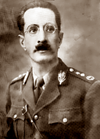 |
1890–1959 | 9 May 1946 | 7 September 1953 | 7 years, 121 days | Independent | |
| Prime Minister; Member of the Barakzai dynasty. | |||||||
| Mohammad Daoud Khan | 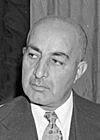 |
1909–1978 | 7 September 1953 | 10 March 1963 | 9 years, 184 days | Independent | |
| Prime Minister; Member of the Barakzai dynasty. | |||||||
| Mohammad Yusuf |  |
1917–1998 | 10 March 1963 | 2 November 1965 | 2 years, 237 days | Independent | |
| Prime Minister. | |||||||
| Mohammad Hashim Maiwandwal |  |
1919–1973 | 2 November 1965 | 11 October 1967 | 1 year, 343 days | Independent (until 1966) |
|
| Progressive Democratic Party | |||||||
| Prime Minister. | |||||||
| Abdullah Yaqta |  |
1914–2003 | 11 October 1967 | 1 November 1967 | 21 days | Independent | |
| Acting Prime Minister. | |||||||
| Mohammad Nur Ahmad Etemadi |  |
1921–1979 | 1 November 1967 | 9 June 1971 | 3 years, 220 days | Independent | |
| Prime Minister. | |||||||
| Abdul Zahir | 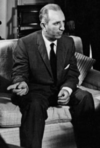 |
1910–1982 | 9 June 1971 | 12 November 1972 | 1 year, 156 days | Independent | |
| Prime Minister. | |||||||
| Mohammad Musa Shafiq |  |
1932–1979 | 12 November 1972 | 17 July 1973 | 247 days | Independent | |
| Prime Minister; Deposed during the 1973 coup d'état. | |||||||
| Post abolished (17 July 1973 – 1 May 1978) | |||||||
| Democratic Republic of Afghanistan (1978–1992) | |||||||
| Nur Muhammad Taraki | 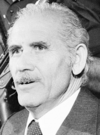 |
1917–1979 | 1 May 1978 | 27 March 1979 | 330 days | People's Democratic Party (Khalq faction) |
|
| Chairman of the Council of Ministers. | |||||||
| Hafizullah Amin |  |
1929–1979 | 27 March 1979 | 27 December 1979 | 275 days | People's Democratic Party (Khalq faction) |
|
| Chairman of the Council of Ministers; Assassinated by Soviet special forces during the Operation Storm-333. | |||||||
| Babrak Karmal |  |
1929–1996 | 27 December 1979 | 11 June 1981 | 1 year, 166 days | People's Democratic Party (Parcham faction) |
|
| Chairman of the Council of Ministers. | |||||||
| Sultan Ali Keshtmand |  |
born 1935 | 11 June 1981 | 26 May 1988 | 6 years, 350 days | People's Democratic Party (Parcham faction) |
|
| Chairman of the Council of Ministers; First tenure. | |||||||
| Mohammad Hasan Sharq |  |
born 1925 | 26 May 1988 | 21 February 1989 | 271 days | Independent | |
| Chairman of the Council of Ministers; Appointed as part of the National Reconciliation process. | |||||||
| Sultan Ali Keshtmand |  |
born 1935 | 21 February 1989 | 8 May 1990 | 1 year, 76 days | People's Democratic Party (Parcham faction) |
|
| Chairman of the Council of Ministers; Second tenure. | |||||||
| Fazal Haq Khaliqyar |  |
1934–2004 | 8 May 1990 | 15 April 1992 | 1 year, 343 days | People's Democratic Party (Parcham faction) (until June 1990) |
|
| Homeland Party | |||||||
| Chairman of the Council of Ministers; Resigned. | |||||||
| Islamic State of Afghanistan (1992–2002) | |||||||
| Abdul Sabur Farid Kohistani |  |
1952–2007 | 6 July 1992 | 15 August 1992 | 40 days | Hezb-e Islami Gulbuddin | |
| Prime Minister. | |||||||
| Post vacant (15 August 1992 – 17 June 1993) | |||||||
| Gulbuddin Hekmatyar |  |
born 1947 | 17 June 1993 | 28 June 1994 | 1 year, 11 days | Hezb-e Islami Gulbuddin | |
| Prime Minister; First tenure. | |||||||
| Arsala Rahmani Daulat |  |
1937–2012 | 28 June 1994 | 1995 | ≈ 1 year | Ittehad-e Islami | |
| Acting Prime Minister. | |||||||
| Ahmad Shah Ahmadzai |  |
1944–2021 | 1995 | 26 June 1996 | ≈ 1 year | Ittehad-e Islami | |
| Acting Prime Minister. | |||||||
| Gulbuddin Hekmatyar |  |
born 1947 | 26 June 1996 | 11 August 1997 | 1 year, 46 days | Hezb-e Islami Gulbuddin | |
| Prime Minister; Second tenure; Fled Kabul following its fall to the Taliban on 27 September 1996; Continued to serve as Prime Minister in areas controlled by the Northern Alliance during the 1996–2001 Civil War; Between 1996 and 2001, the Islamic State remained the internationally recognized government, despite only controlling about 10% of Afghan territory. | |||||||
| Abdul Rahim Ghafoorzai |  |
1947–1997 | 11 August 1997 | 21 August 1997 | 10 days | Independent | |
| Prime Minister; Served only in areas controlled by the Northern Alliance due to the 1996–2001 Civil War; Between 1996 and 2001, the Islamic State remained the internationally recognized government, despite only controlling about 10% of Afghan territory; Killed in an aircraft crash. | |||||||
| Islamic Emirate of Afghanistan (1996–2001) | |||||||
| Mullah Mohammad Rabbani |
 |
1955–2001 | 27 September 1996 | 13 April 2001 | 4 years, 198 days | Taliban | |
| Deputy Head of the Supreme Council; Prime Minister; Deputy leader of the Taliban; Died in office; Between 1996 and 2001, the Islamic Emirate never attained widespread international recognition, despite controlling about 90% of Afghan territory. | |||||||
| Mawlawi Abdul Kabir |
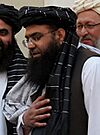 |
born 1958 | 16 April 2001 | 13 November 2001 | 211 days | Taliban | |
| Acting Deputy Head of the Supreme Council; Acting Prime Minister; Deposed during the fall of Kabul. | |||||||
| Post abolished (13 November 2001 – 7 September 2021) | |||||||
| Islamic Emirate of Afghanistan (2021–present) | |||||||
| Mullah Hasan Akhund |
 |
between 1945 and 1958 | 7 September 2021 | Incumbent | 3 years, 213 days | Taliban | |
| Acting Prime Minister; The Islamic Emirate is currently not internationally recognized, despite controlling all Afghan territory. Hasan Akhund spent 17 May to 17 July 2023 in Kandahar recovering from an illness, during which his deputy Abdul Kabir carried out the duties of the prime minister. | |||||||
| Mawlawi Abdul Kabir |
 |
born 1958 | 17 May 2023 | 17 July 2023 | 61 days | Taliban | |
| Acting Prime Minister pro tempore while Hasan Akhund was recovering from an illness. | |||||||
Timeline
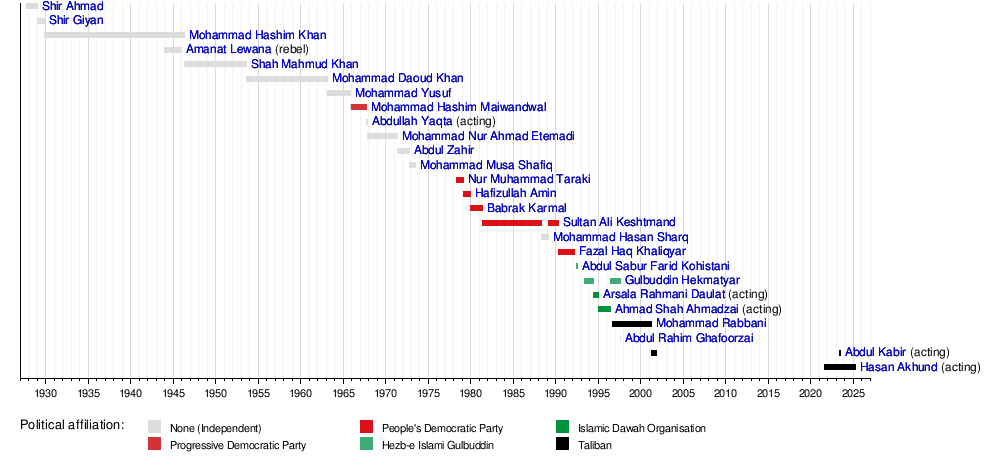
See also
 In Spanish: Primer ministro de Afganistán para niños
In Spanish: Primer ministro de Afganistán para niños
- Supreme Leader of Afghanistan
- President of Afghanistan
- List of heads of state of Afghanistan
- Chief Executive (Afghanistan)
- Deputy Prime Minister of Afghanistan


